Overview
"An adventure through nature."
Socialization is a key aspect of child development. Our Adventure Through Nature aims to provide a refreshing and practical playground experience for kids of all ages by providing a space full of discovery and excitement that upholds social distancing as a key value. This entails designing a cohesive system of play 'features' which, on their own, engage imaginations and promote physical exercise; and as a whole, foster a natural separation of families.

Research
Inclusive playgrounds should be accessible, engage children of all ages and abilities and encourage them to interact with each other.
Inclusive Playgrounds
Inclusive playgrounds provide a large variety of play. The goal is to have activities for all senses grouped by skill level.
- Auditory: i.e. musical instruments, talking tubes
- Proprioceptive: i.e. climbing products, sand
- Tactile: i.e. climbing rocks, sand
- Vestibular: i.e. spinners, swings, balance
- Visual: colored panels, telescopes, etc.
These areas should also balance different environments of play.
- Cooperative
- Solitary
- Onlooker
- Parallel
- Associate
There should be ground level play for children requiring wheelchairs or otherwise physically impaired.
Competitive Analysis
Initial Journey Mapping and Personas


Interviews with Parents
Our goal was to answer the following questions: 1
- What kind of outside place will you take your kids to? (before or after covid)
- Do you think it’s important for kids to go to playgrounds? Why?
- What are the things you most concern about when taking your kids out during covid?
- If there is an outdoor playground that is designed to practice good social distancing, will you be willing to bring your kids to? If not, why? What are your concerns?
- How do you feel about having playgrounds be a shared space with other age groups? For exercise, art gallery, etc.?
We spoke with 5 parents, 2 with design/architecture backgrounds, and 1 with a background in early childhood development. We've learnt:
- parents are incredibly resourceful in creating play in and out of the playground for their children.
- parents universally agree playgrounds are a core part of child development
- parental concerns on playgrounds often lie in their children being physically harmed, bullied, or being out of sight; not on the dangers of contracting COVID-19 as we originally thought
- Parents living in the suburbs find playgrounds being a shared space with adults creepy; parents in cities are familiar with the overlapping use of spaces
We were also given tons of suggestions (often conflicting!) for essential aspects of the playground both for play and social distancing.
It was universally agreed upon that trying to force children to be socially distanced is impossible. The only way to separate children is to have repeated play objects spread apart.
Process
How can a single person's idea be molded and stretched to fit the vision of 5 people? Lots and lots of iteration.
Every detail has to be considered.
A playground seems like a simple concept at first glance. Plop a couple slides and swings on some dirt and "Voila!" It's much much much more involved.
Some questions we needed to ask ourselves:
- Where would this playground go?
- What ages is it for?
- Is there a theme? What is it?
- What do children actually like about playgrounds?
- Is there a system to orient the playground design around? What is it?
All of these don't even consider measures for social distancing.
The following sections provide a glimpse of the various iterations in many forms to come to a single narrative/direction to carry our playground through future work.
Brainstorming
We started by brainstorming all the different themes we could focus on for the playground. Of the over 100 ideas we came up with, we began narrowing down to: Nature, Space, LEGOs, Animals, History, Careers, Music, and Time Travel.








Narrowing
From there, we further narrowed to Nature and Space.
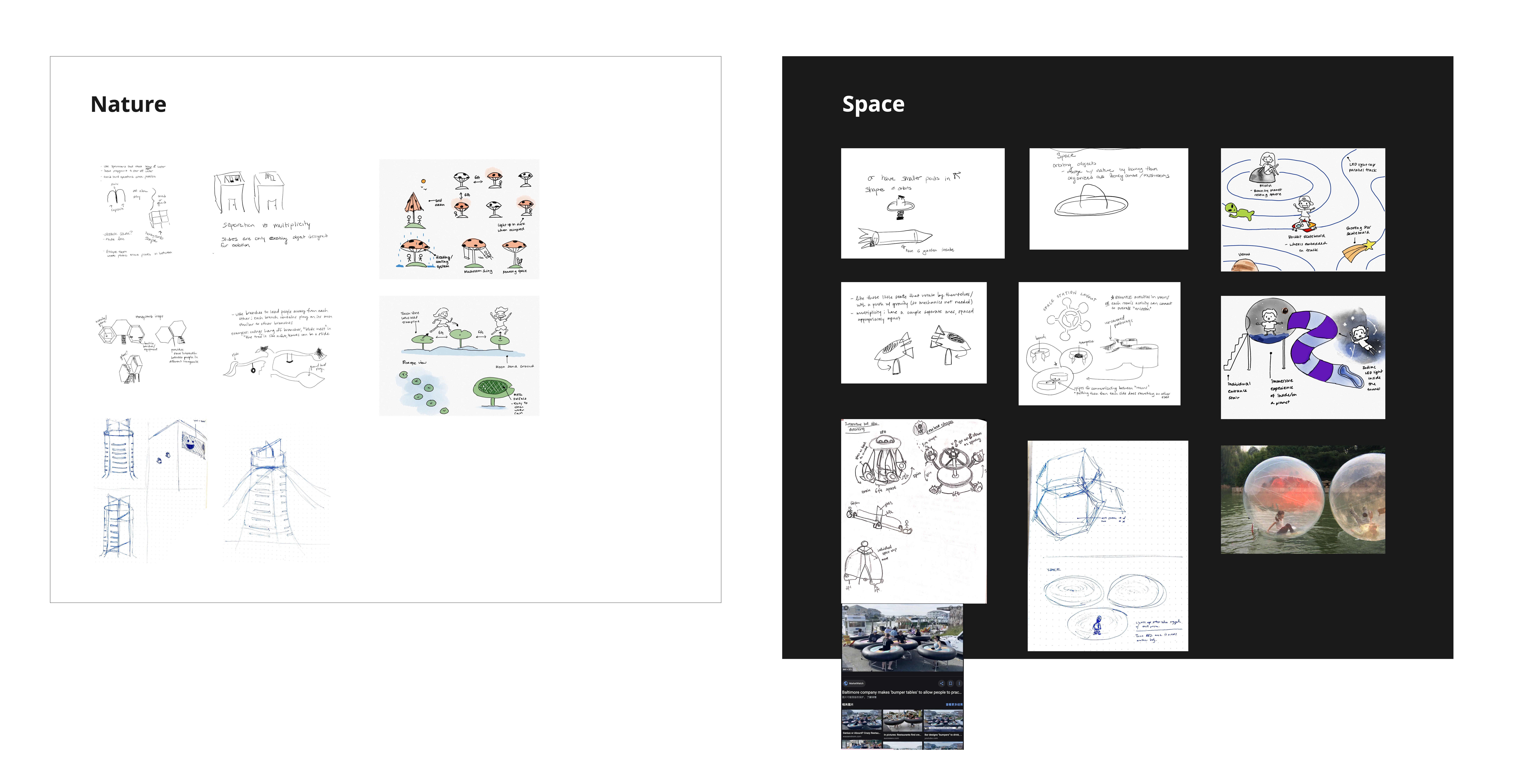
We didn't want to choose one yet, so we then focused on finding a system that would provide us with a lot of inspiration.

Of which we chose 3 to storyboard:

Storyboarding
We then separated out the pros and cons of each system and theme reaching a single, coherent, inspirational narrative to guide our future work.

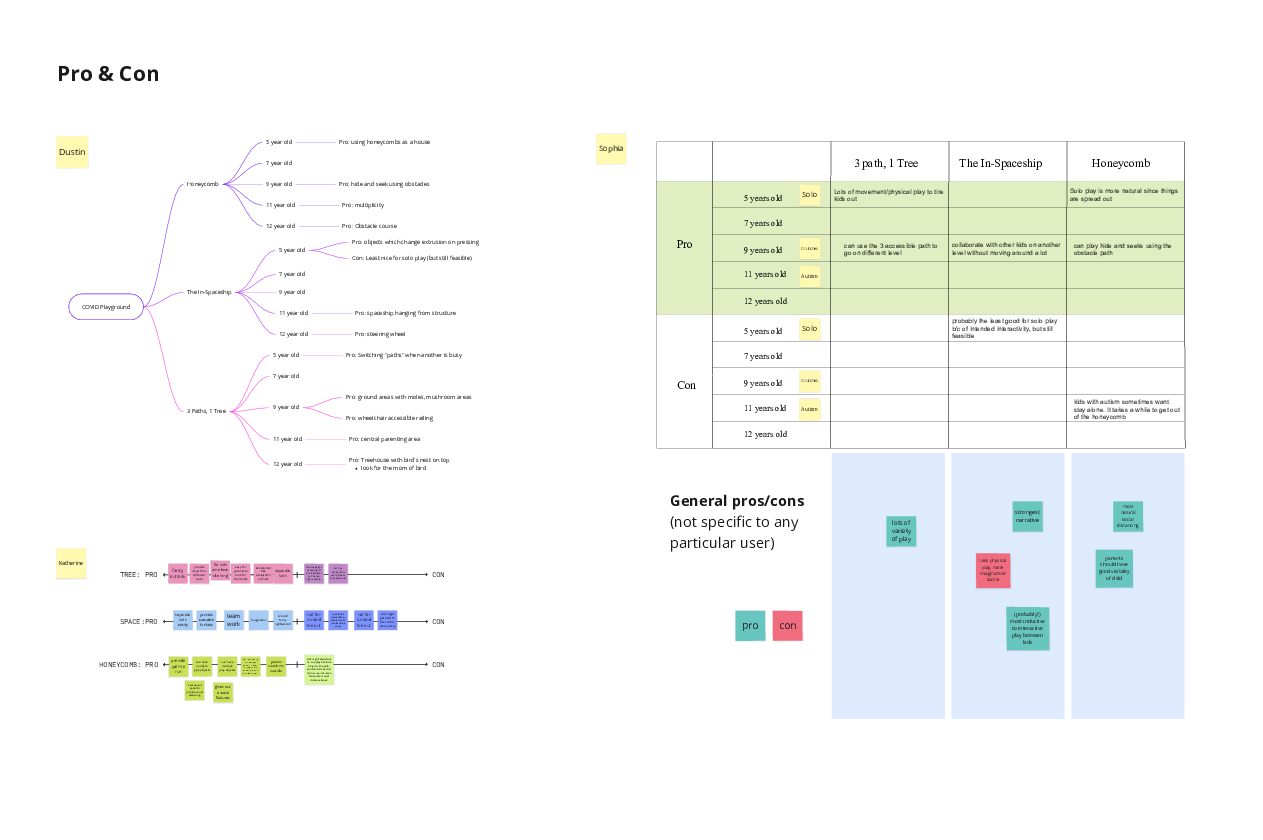
Which cultimated in our high fidelity isometric sketches.
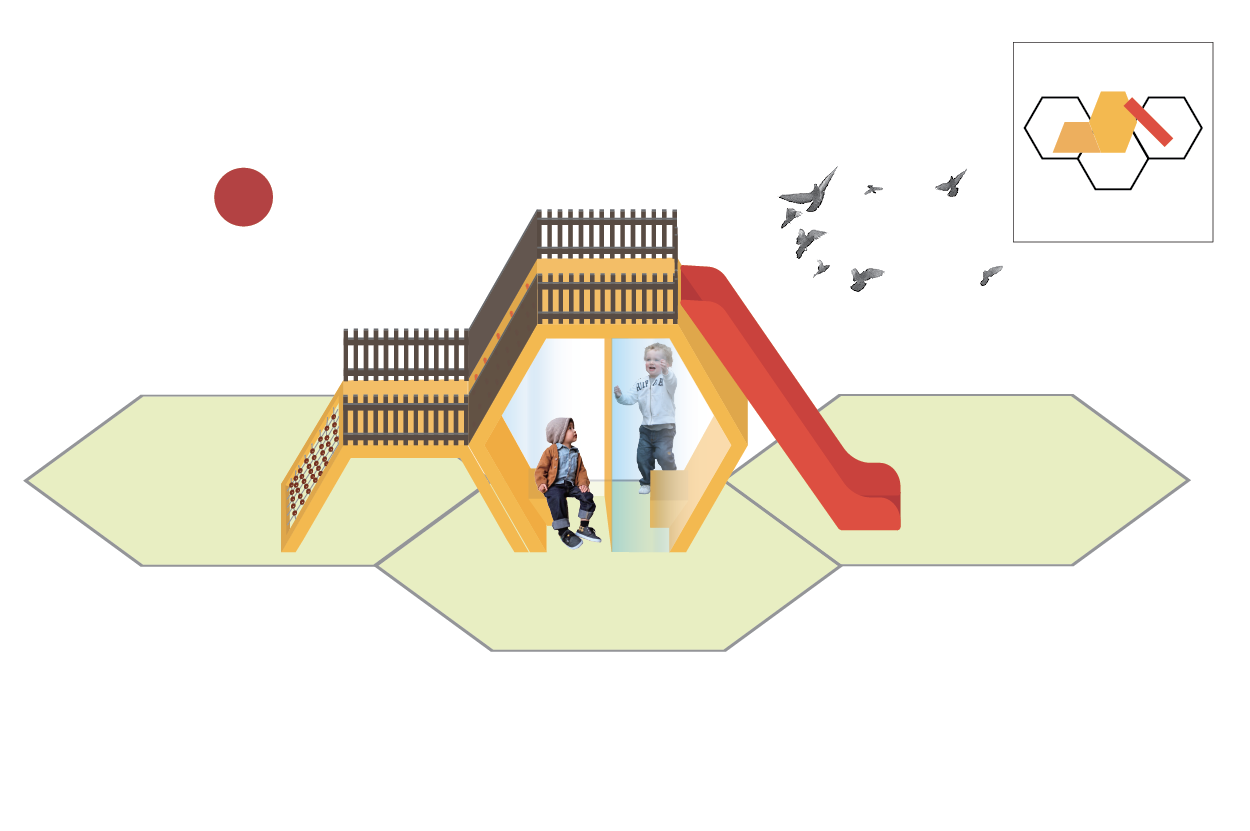
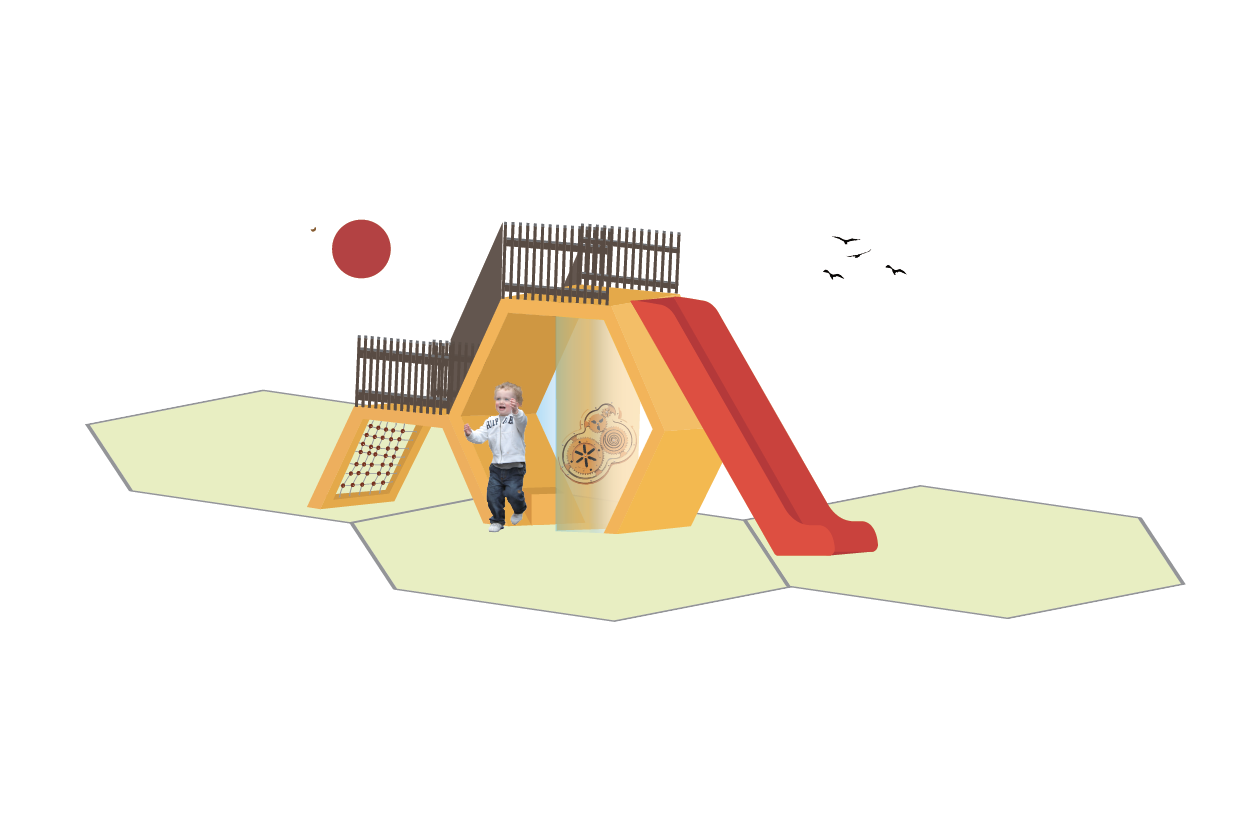
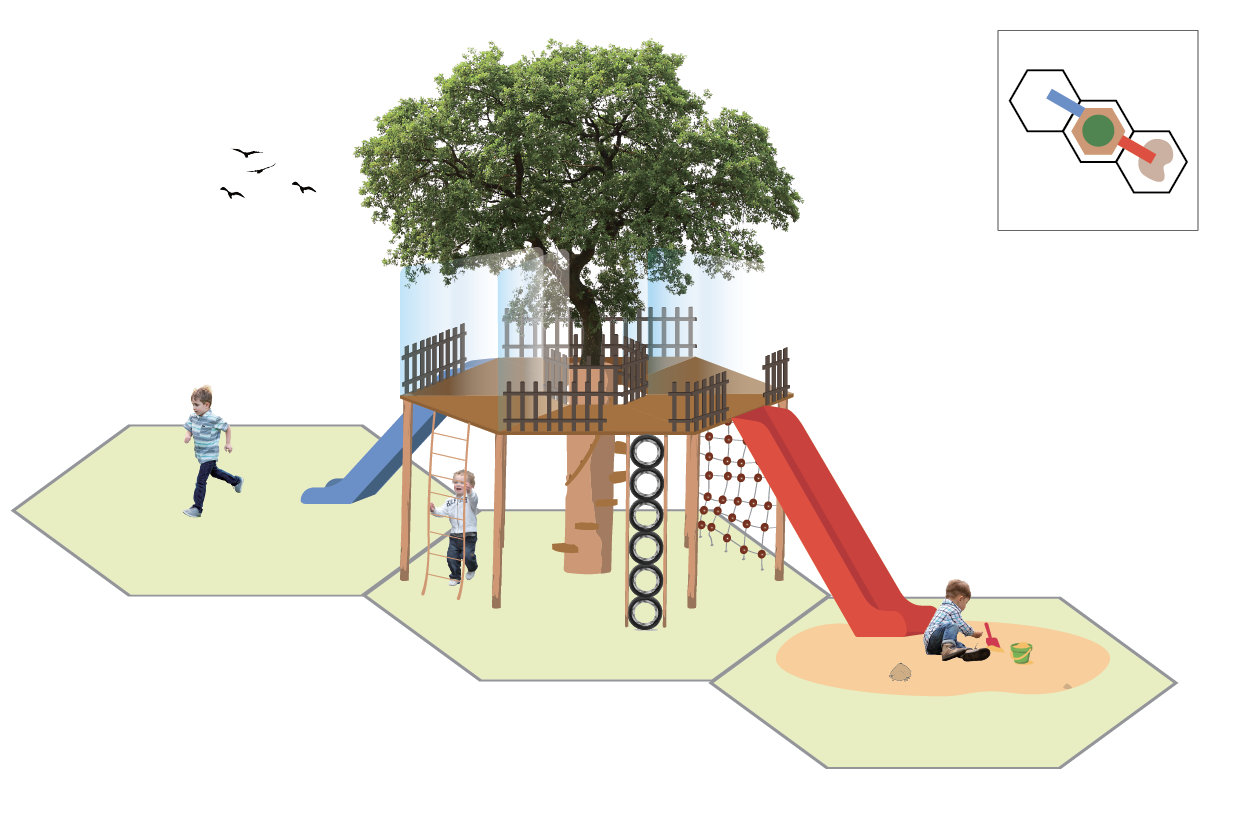
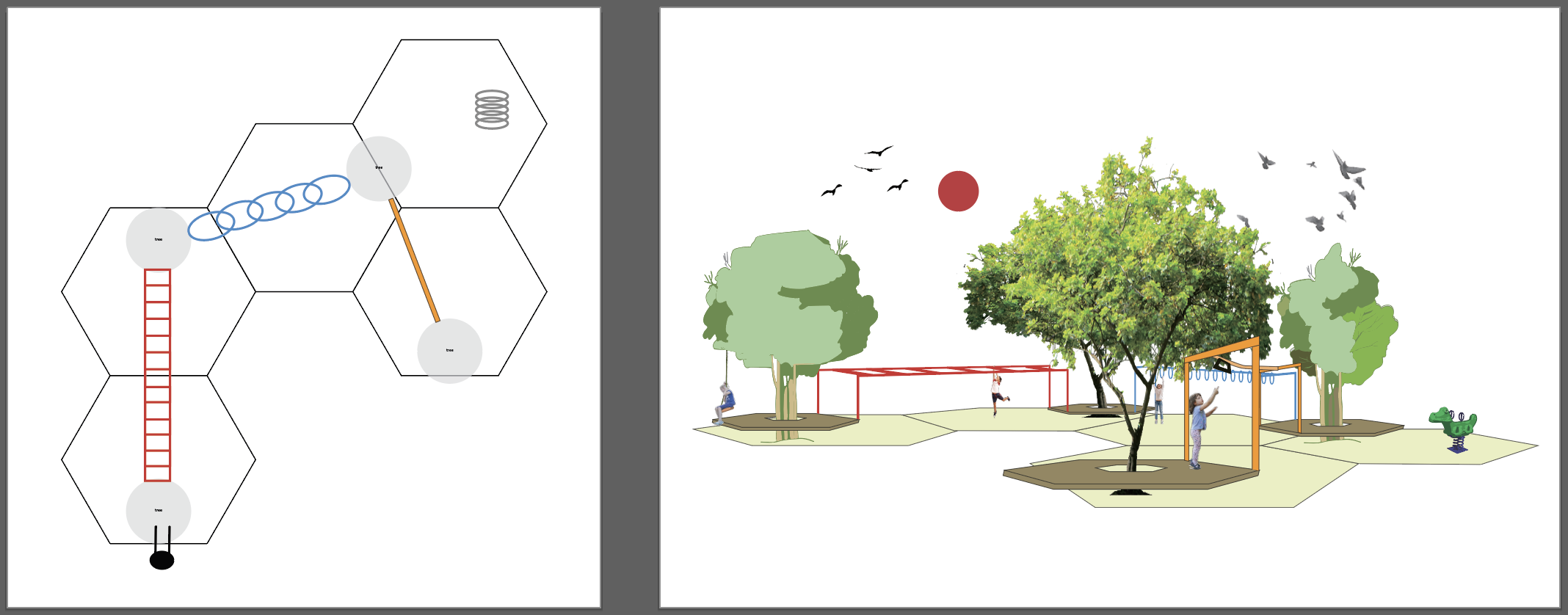

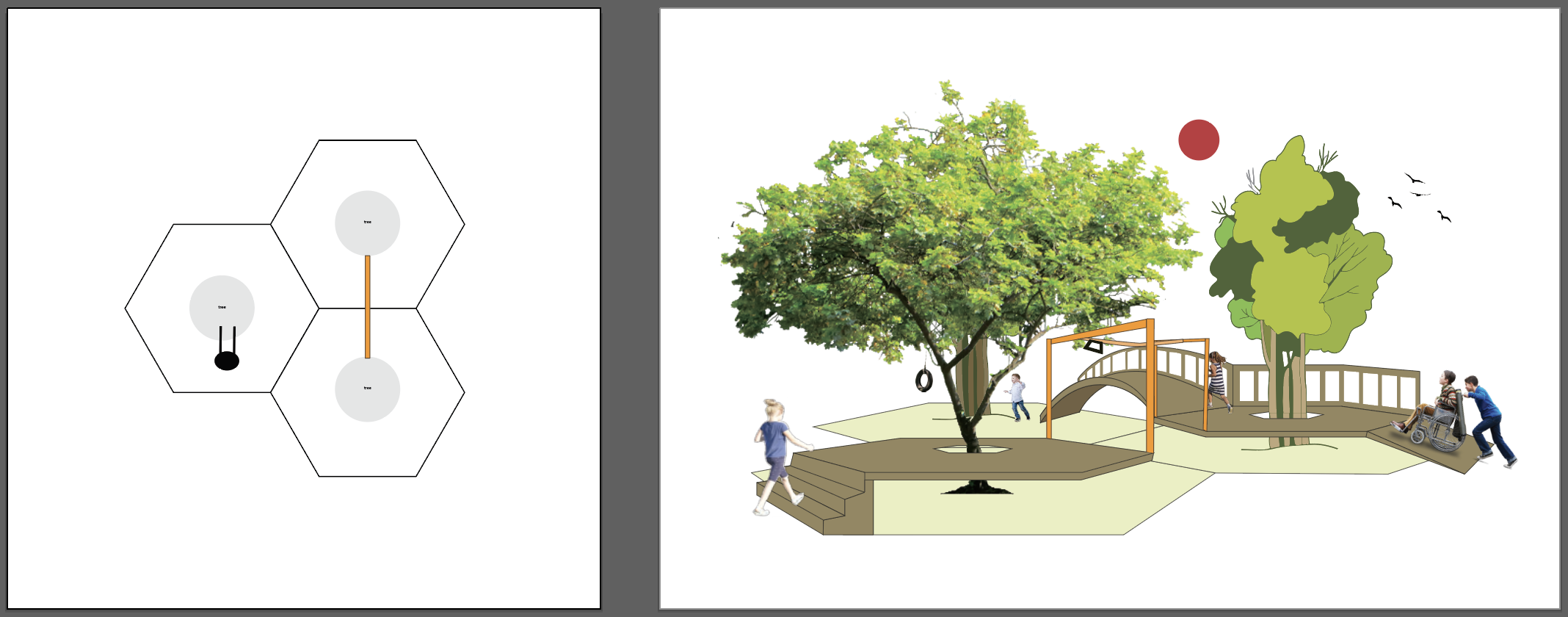
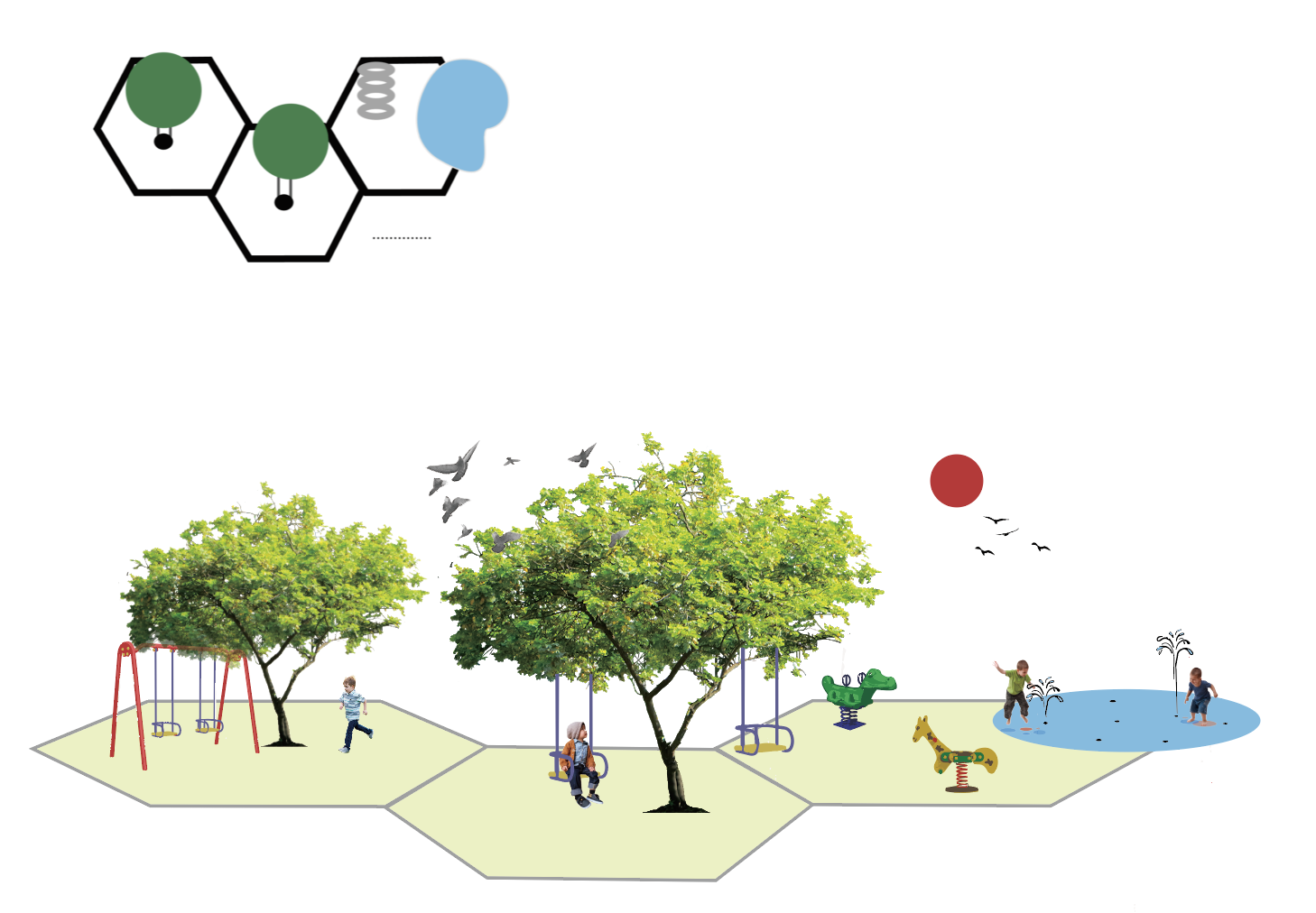
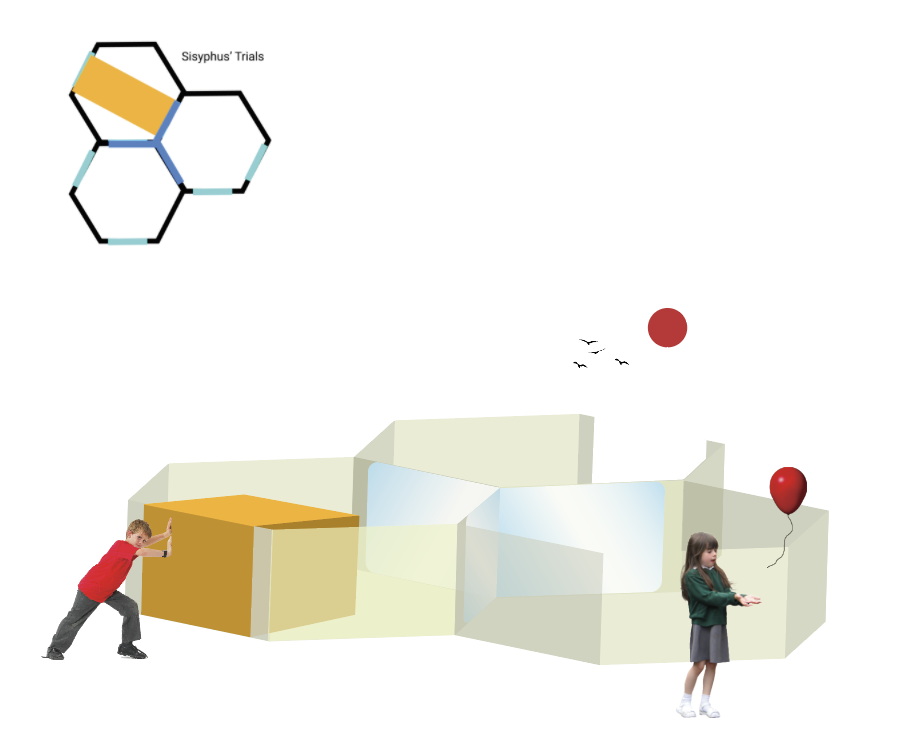
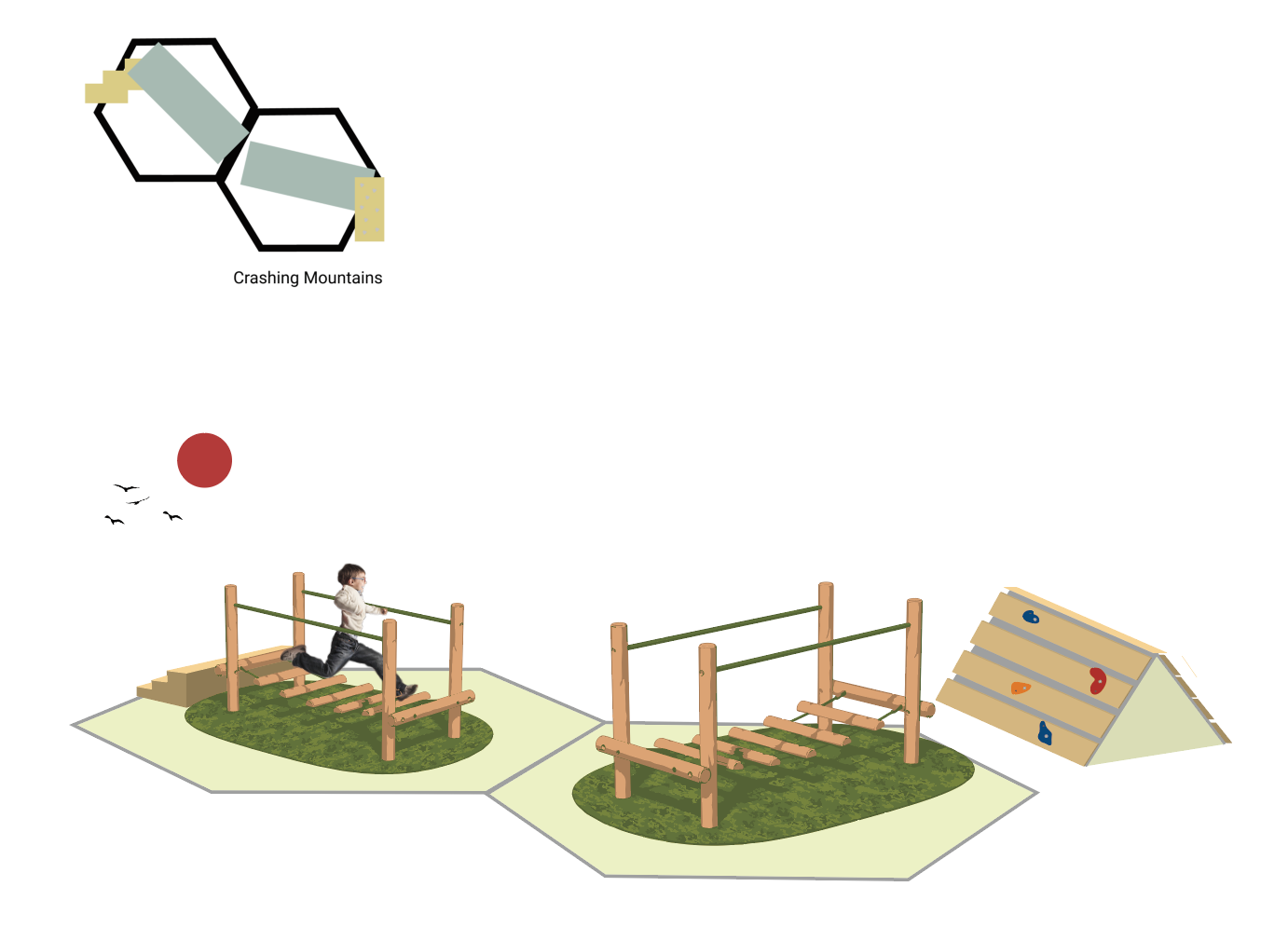
Narrative
A core accomplishment of this semester's work was discovering our guiding narrative for this playground.
"An adventure through nature."
This is the first piece of information when you come to this book and it's our goal to provide this as an experience.
To that end, we've designed 7 spaces.
Arrival House

Inspired by the spaceship in Arrival, Arrival House encompasses the desire to "play house." With a clear plastic split interior, multiple children can create noise, pretend to make a pie for a friend, or pop out and go down the slide.
Tarzan

Inspired by Tarzan, Tarzan encompasses the freedom of "gliding through trees." Low platforms, rings, and monkey bars provide the experience of climbing trees with the stability of modern playground structures.
Forbidden Forest

"As ever, I would like to remind you all that the Forest in the grounds is out-of-bounds to students."
-- Dumbledore
Discover what lurks in the shadows! Swings, ziplines, and drawbridges stand as props to allow the imagination to soar.
Swing land

Freedom through flight. Reach the tallest towers and swing over the trees themselves in this immersive space with swings in all shapes and sizes and sprinklers for the warmest days.
Sisyphus' Trial

"In Greek mythology Sisyphus or Sisyphos was the king of Ephyra. He was punished for his self-aggrandizing craftiness and deceitfulness by being forced to roll an immense boulder up a hill only for it to roll down every time it neared the top, repeating this action for eternity."
Wikipedia
This clear plastic enclosed space is the epitomy of socially distanced play. Like Sisyphus, you must push a boulder in order to enter. If you can acheive what Sisyphus could not, you can lord it over the entire playground.
Tree House

It's scientifically unproven that every child desires a tree house. Now, everyone can fulfill this dream with ladders for every age, slides, sand play, and more!
Crashing Mountains

"The Symplegades or Clashing Rocks, also known as the Cyanean Rocks, were, according to Greek mythology, a pair of rocks at the Bosphorus that clashed together whenever a vessel went through. They were defeated by Jason and the Argonauts, who would have been lost and killed by the rocks except for Phineus' advice"
Wikipedia
Experience the same frought journey Jason and the Argonauts endured to retrieve the Golden Fleece. These draw bridges are constantly trying to reach each other and squish unsuspecting boats.
Expectations Fall 2020 for Work in 2021
The bulk of our future work lies in the conversion of our 2D sketches in to a three-dimensional model.
What we're using
Autodesk Fusion360 is the industry standard for collaborative 3D modelling software.
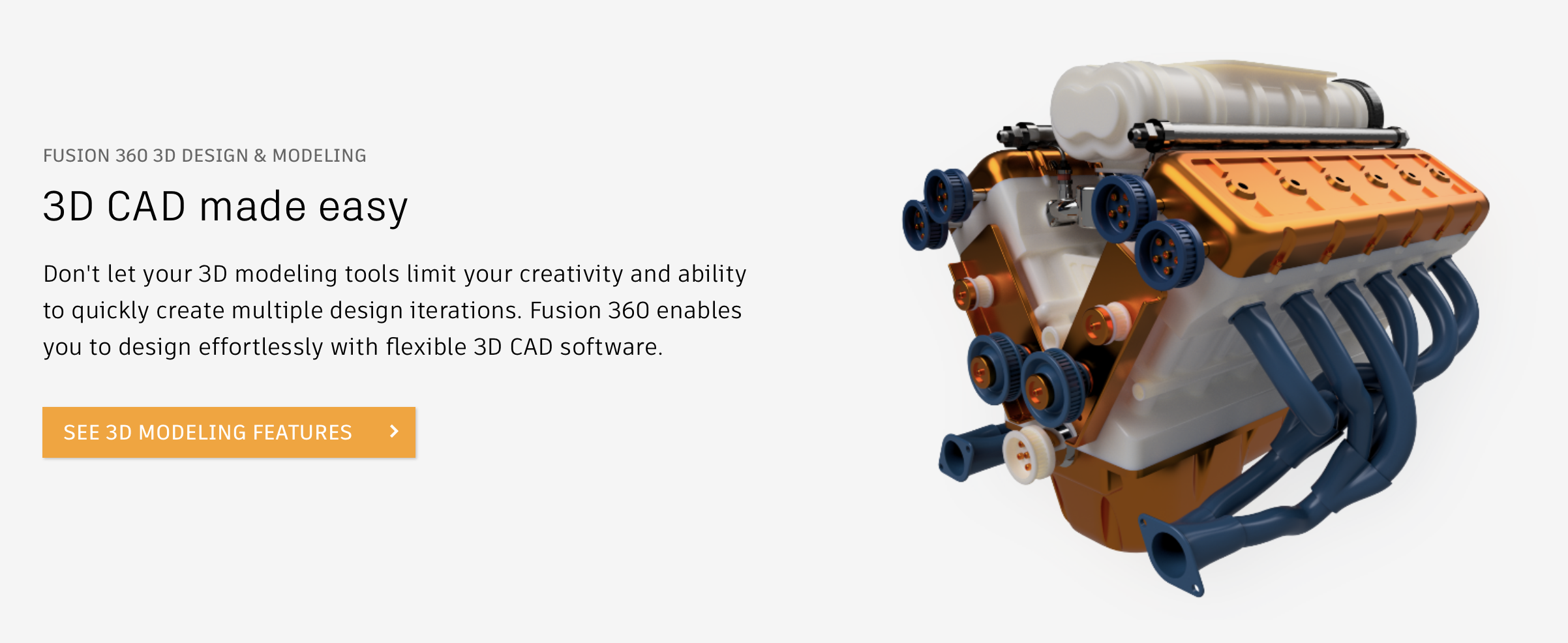

Blender has UV unwrapping which is good for adding materials image to models.
The End Goal
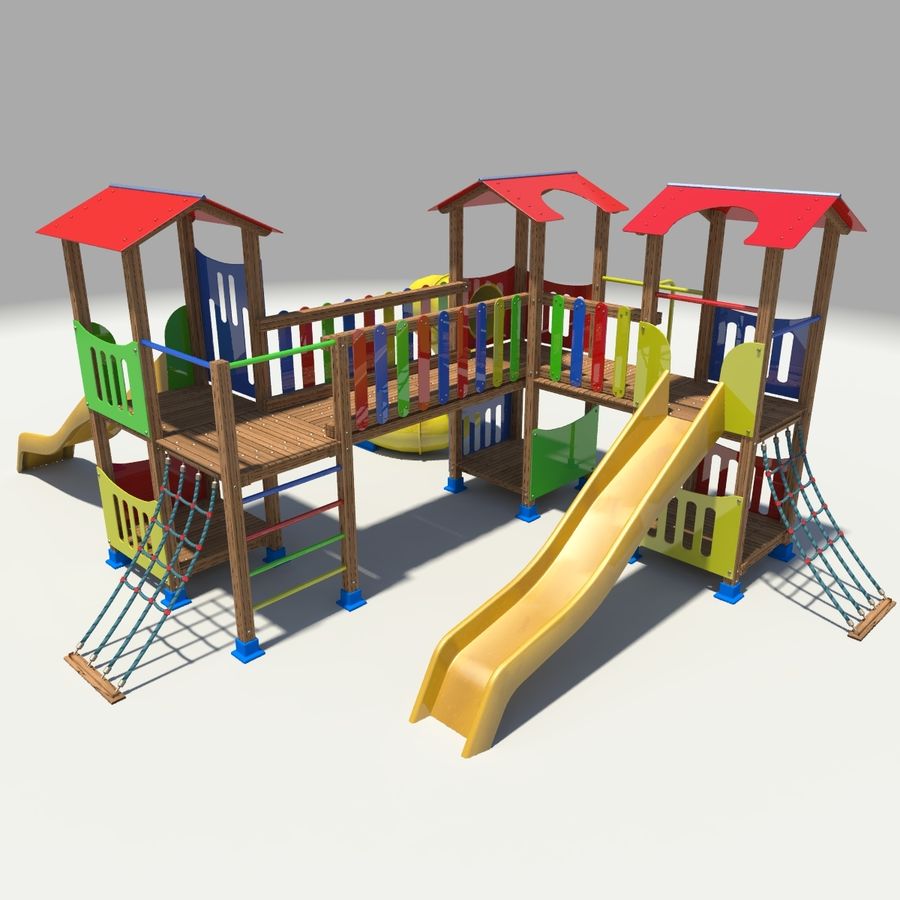
We intend to create a model similar to the one above. Depending on how long that takes, we may move on to crafting a VR experience guiding viewers through the narrative of our playground.
Just because we have a clear narrative, our design process is not complete. We fully intend to have an iterative, human centered approach to our design.
We intend to keep on one or two of our interview participants and a playground expert we spoke to, to ascertain the following:
- Best building materials
- Potential self-cleaning technologies/strategies
- Level of fun/adventure in design
- Soundness of design (towards buildability and social distance promotion)
- Visual design
Throughout our building of the 3D model, we will consult these participants to ensure we can create the best socially distanced playground possible.
Standards
| Shape | Diameter (m) | Depth (m) | Length of Side (m) | Distance from Ground (m) |
|---|---|---|---|---|
| Hexagon | 3.66 | 0 | 2.11 | 0 |
| Elevated Hexagon | 3.66 | 0.15 | 2.11 | TBD |
Grid Hexagons must touch.
Library
Non-Exhaustive List:
- Thick Tree
- Tire Swing
- Slide
Blender Tips
- Tab to swap between Edit and Object mode
- Shift + A to add objects
- Install Sapling Gen to create trees
- F in edit mode allows adding a face
- To make a hexagon, Shift + A to add a Cylinder and in the modal in the bottom left set vertices to
6(and radius to1.83)
3D Modeling
The bulk of our semester involved 3D modelling.
Over the course of the last 3 months we've iterated in a variety of ways through our models to come to a final polished output.
Tools: Fusion 360, Blender
Early stages

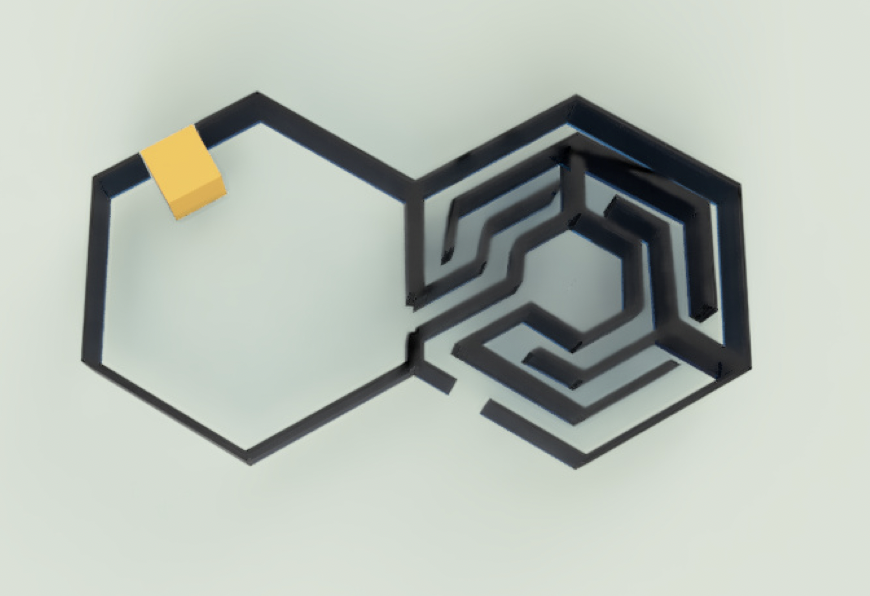
Iteration on Islands
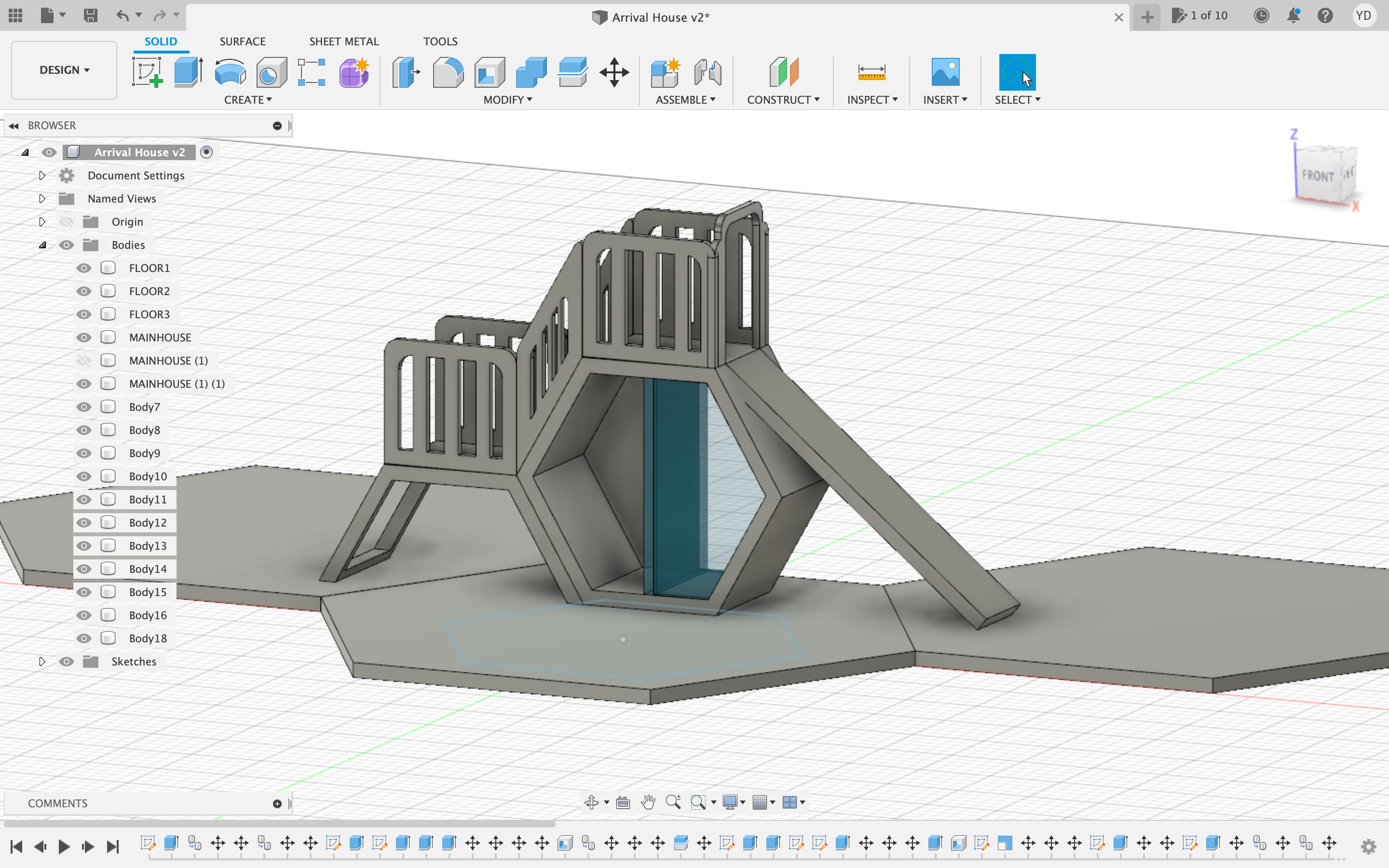
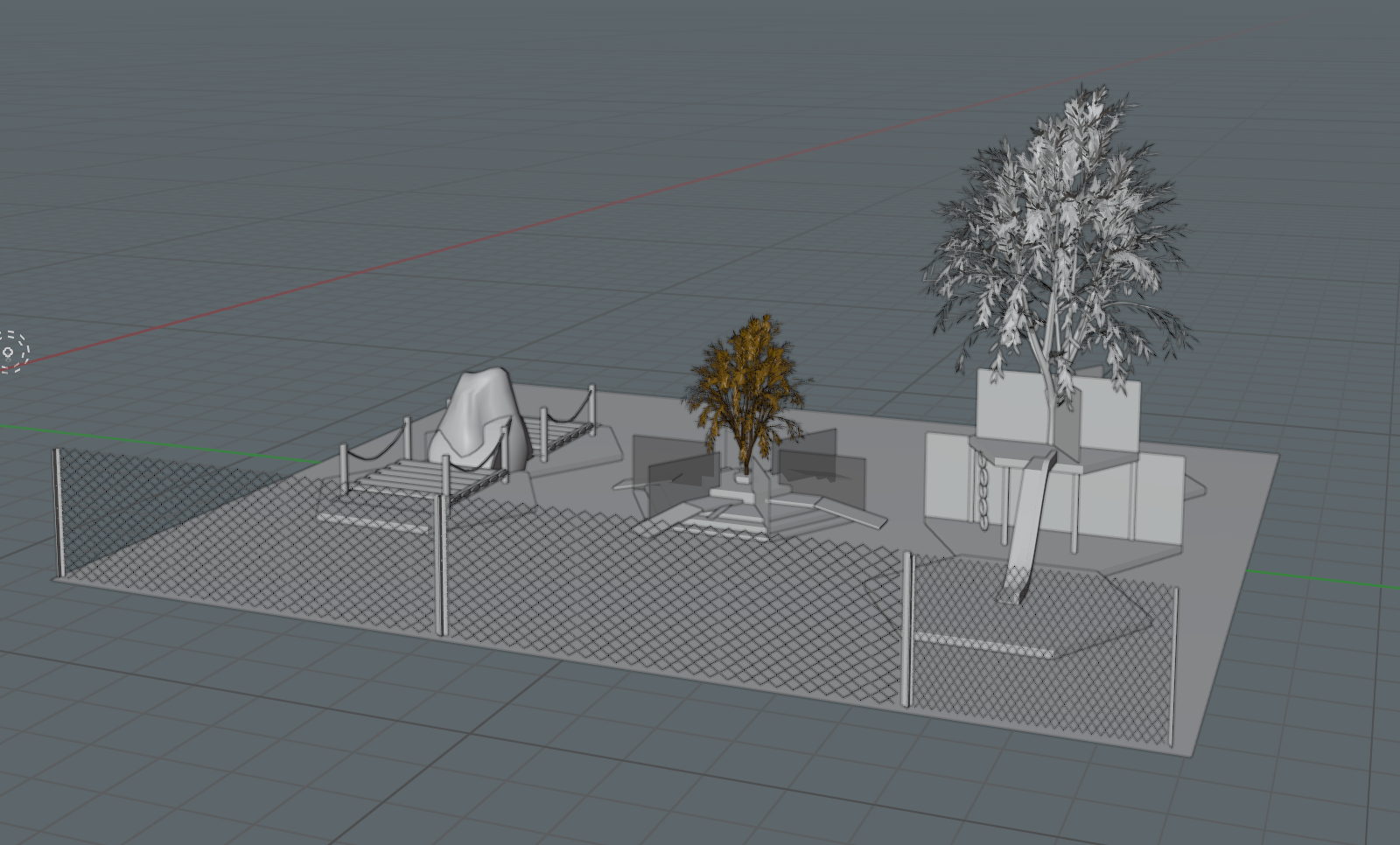
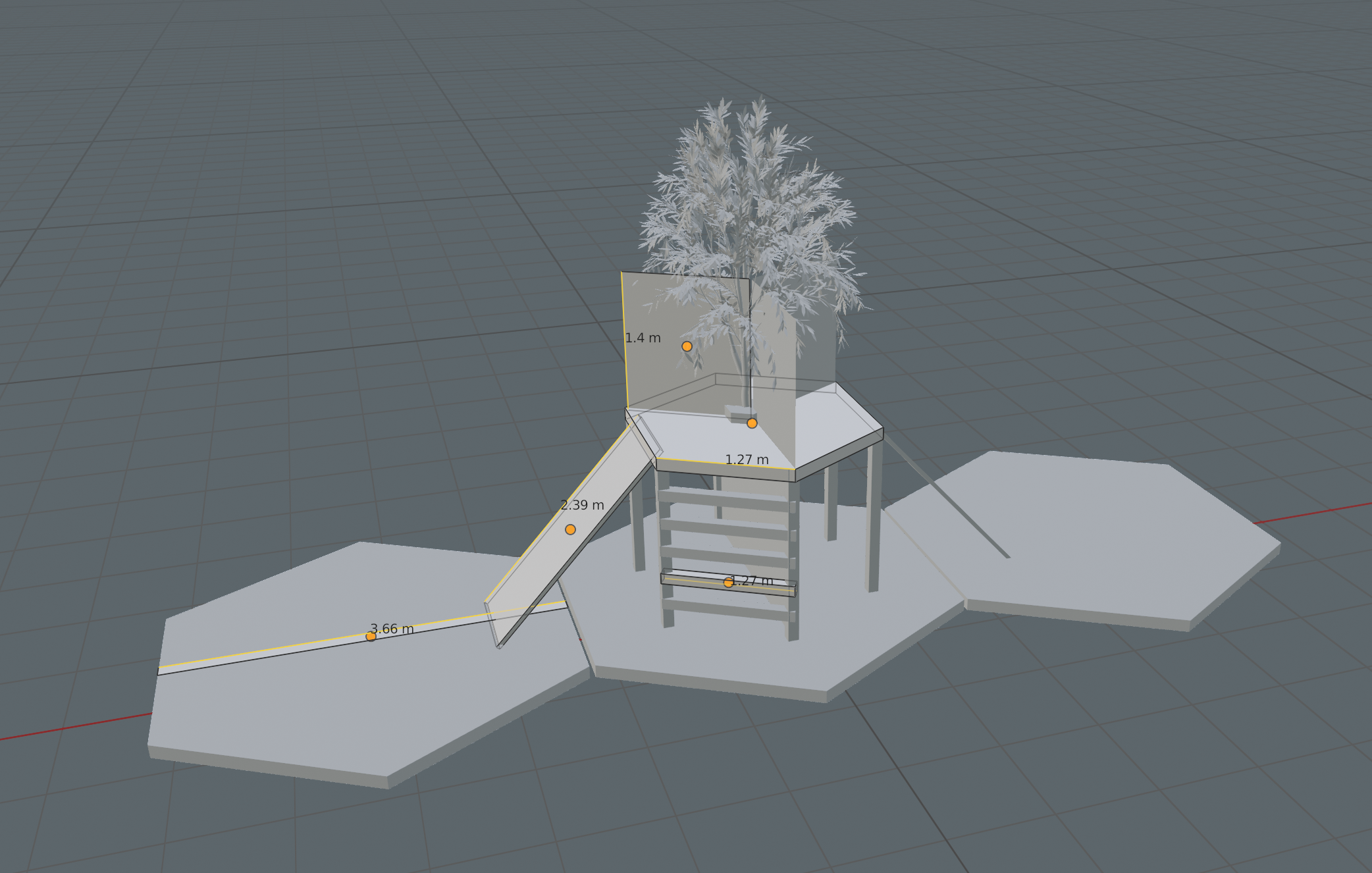
Exploration of real playgrounds for scale comparisons and real-to-life verifications
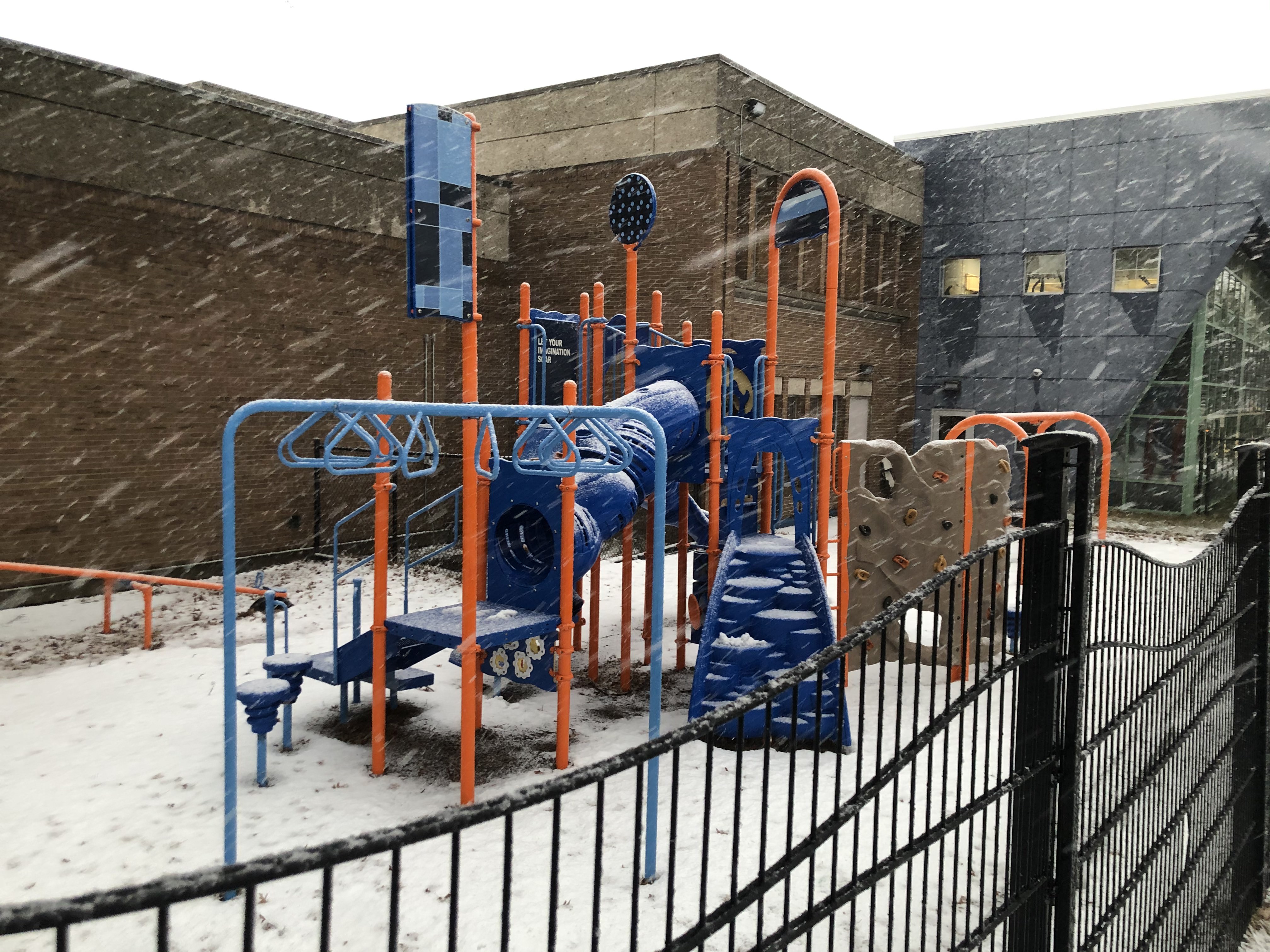

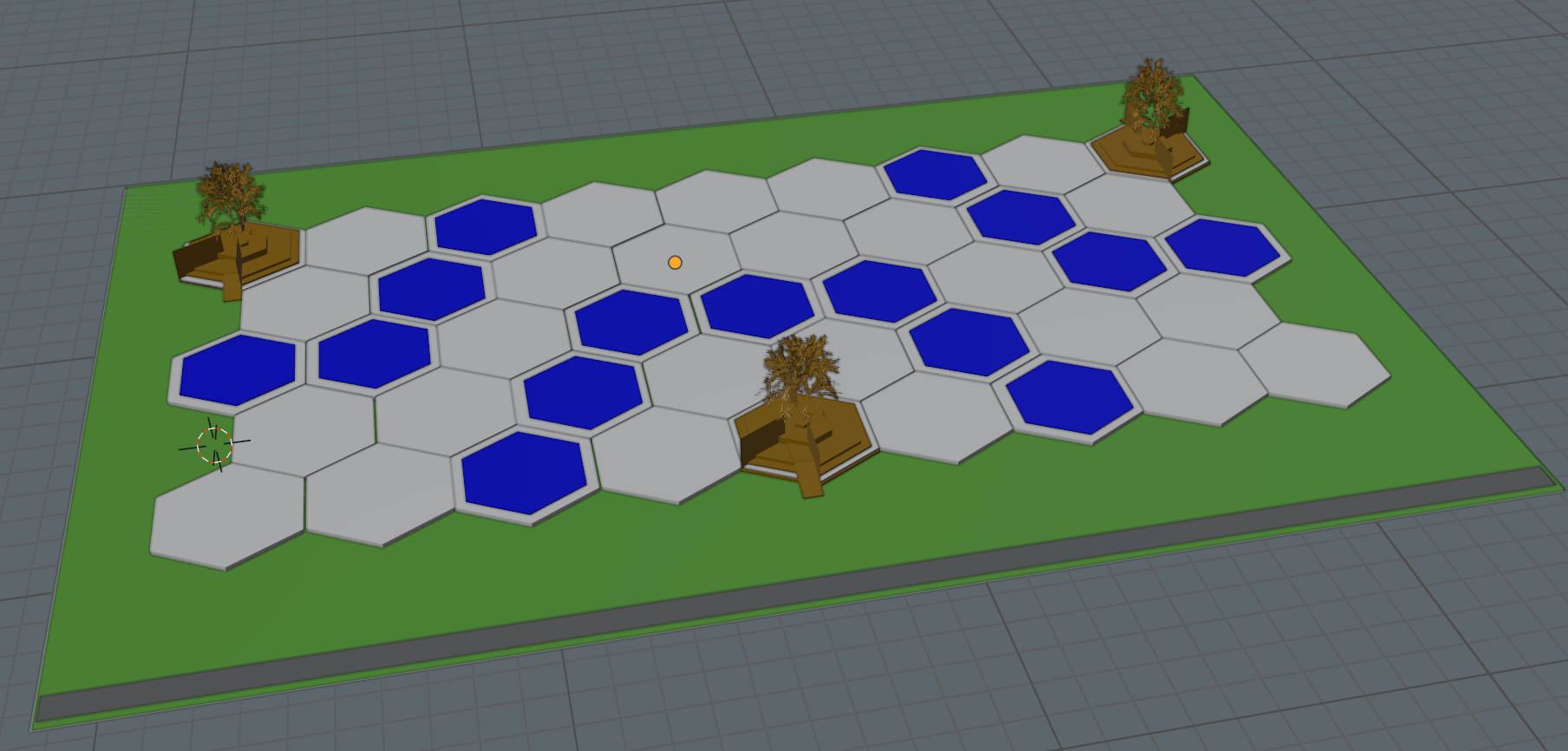
For all final 3D models, visit our website.
User Testing
Overview for spring semester
Round 1 - Expert
Expert: Architect, with background in modularity
Feedback Highlights:
- Airflow can be improved in areas in the maze and arrival house. Adding windows can help or potentially adjust the space to afford movement
- Plexiglass poses potential issues with safety if the kids are running around; consider decorating with murals or games to visually indicate a barrier is there
- Crashing mountain island poses COVID and regular safety concerns because of the way kids move on the structure, and the bottom of the climbing wall is not soft
Round 2 - Users
Method: Primarily remote testing via video conferencing
Tools: Arki (Augmented Reality), Zoom
Originally we were thinking about making 3D prints and bring them to people for user testing. But becuase of the covid pandemic, it creates difficulties for offline user testing. So we use Arki to create AR for usertesting.
Video walkthrough of our playground using Arki: link
Users: 6 total children, ages 3-11.
Feedback Highlights:
- Safety concerns regarding materials used and the scale of structures (Note: scale was a little bit lost in translation through augmented reality)
- Better idea about which islands seem the most fun; suggestions for improving the slides to swirly slides for increasing fun
- The extra space and multiplicity was noticable but did not take away from the fun of the structures
Visual and Material Design
After 3D modeling, we moved into visual and material design. We first created a moodboard which we picked out the colors that will be used on our playground.

Then we researched playground materials. Here is the list of it:

For more details about each materials and playground policy, visit Playground materials and safety
Example of adding colors and materials in Blender:
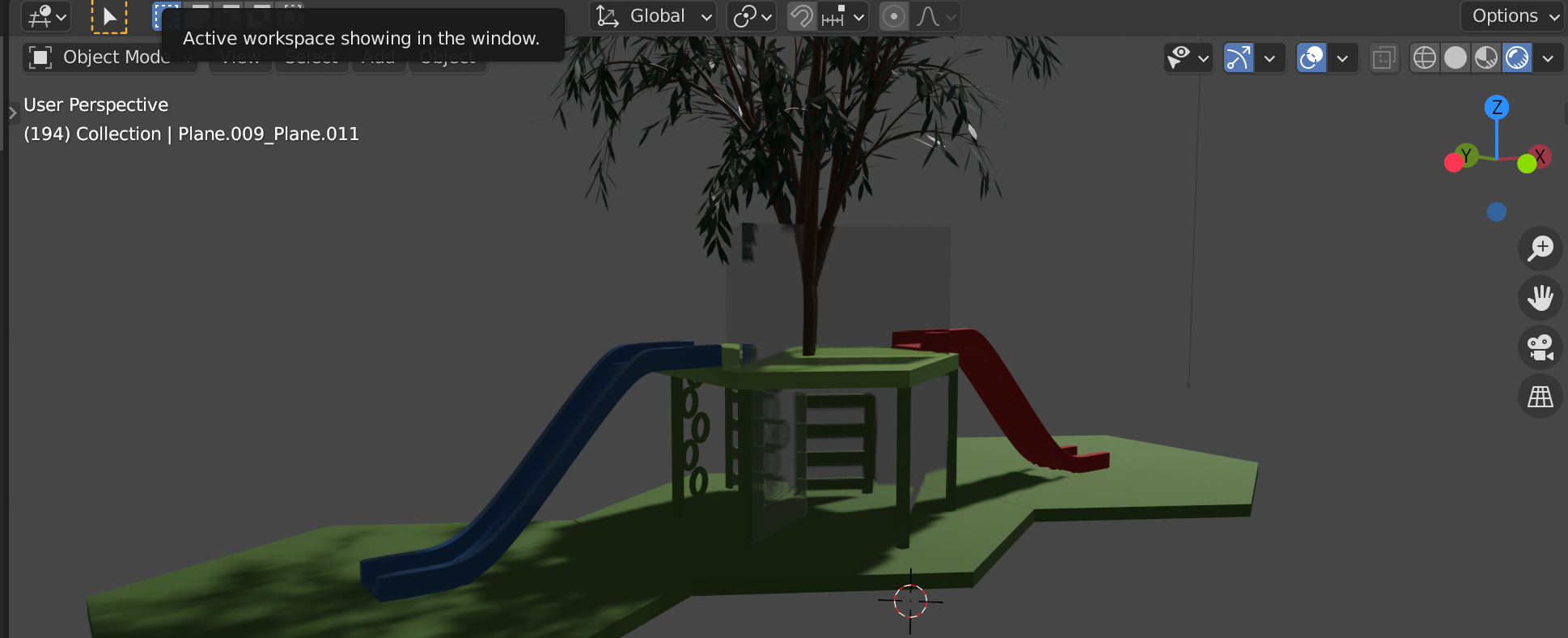
Building Video and Photo Realistic Renders
Photorealistic rendering
To better showcase our models, we rendered each individual model directly in blender. We added a hdr background and adjusted the light to create shadows on the models.

This provides a hyper-realism great for showcasing the models on our website.
Video rendering
Video rendering provided to be a challenge, as our complex environment paired with proper light treatments took roughly 2-3 minutes per frame out of a total 3000+ frames. After being unable to finish a full render of our animation at this level of detail, we settled for very minimal settings, to make sure the entire animation was at least rendered to some degree.
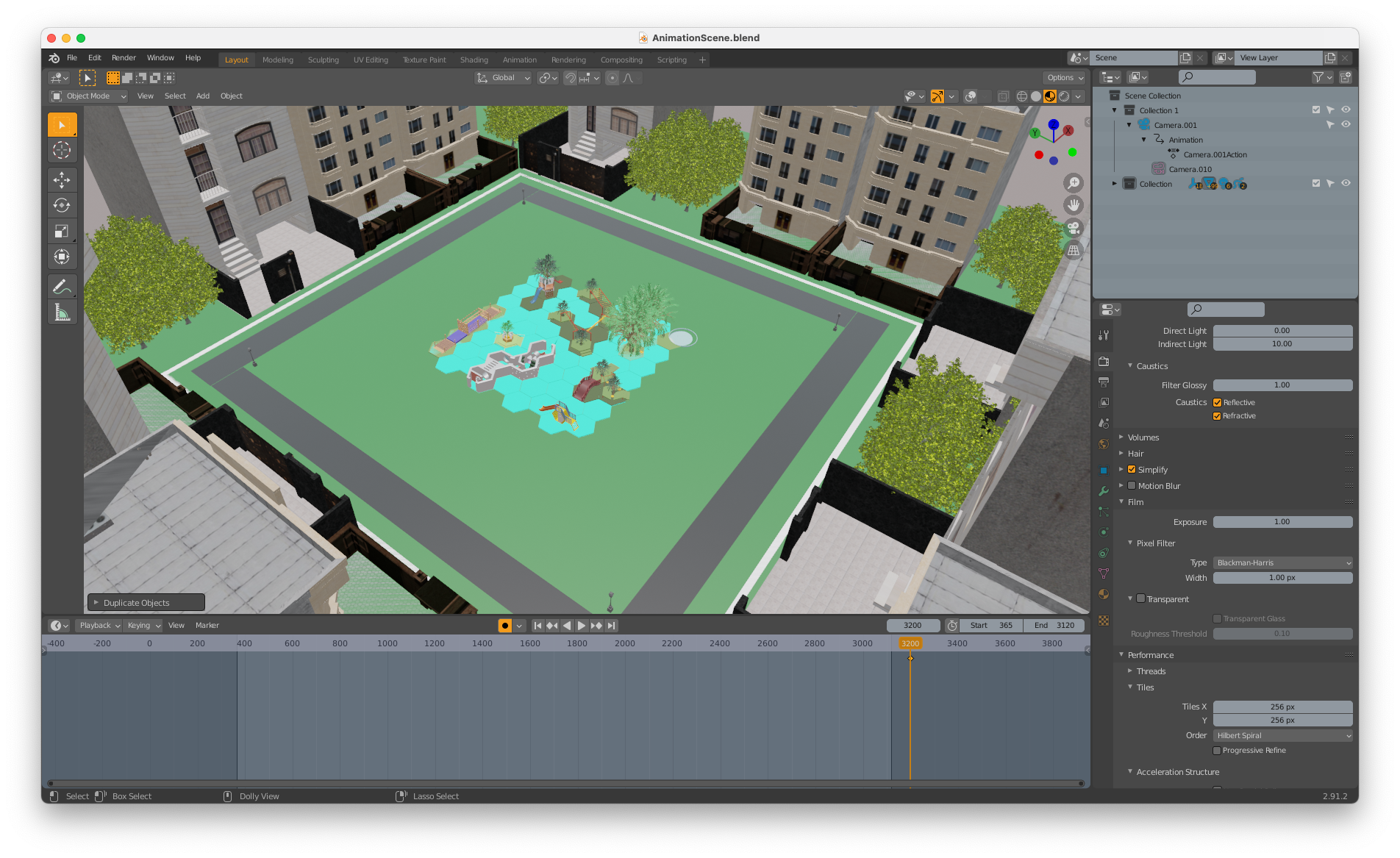
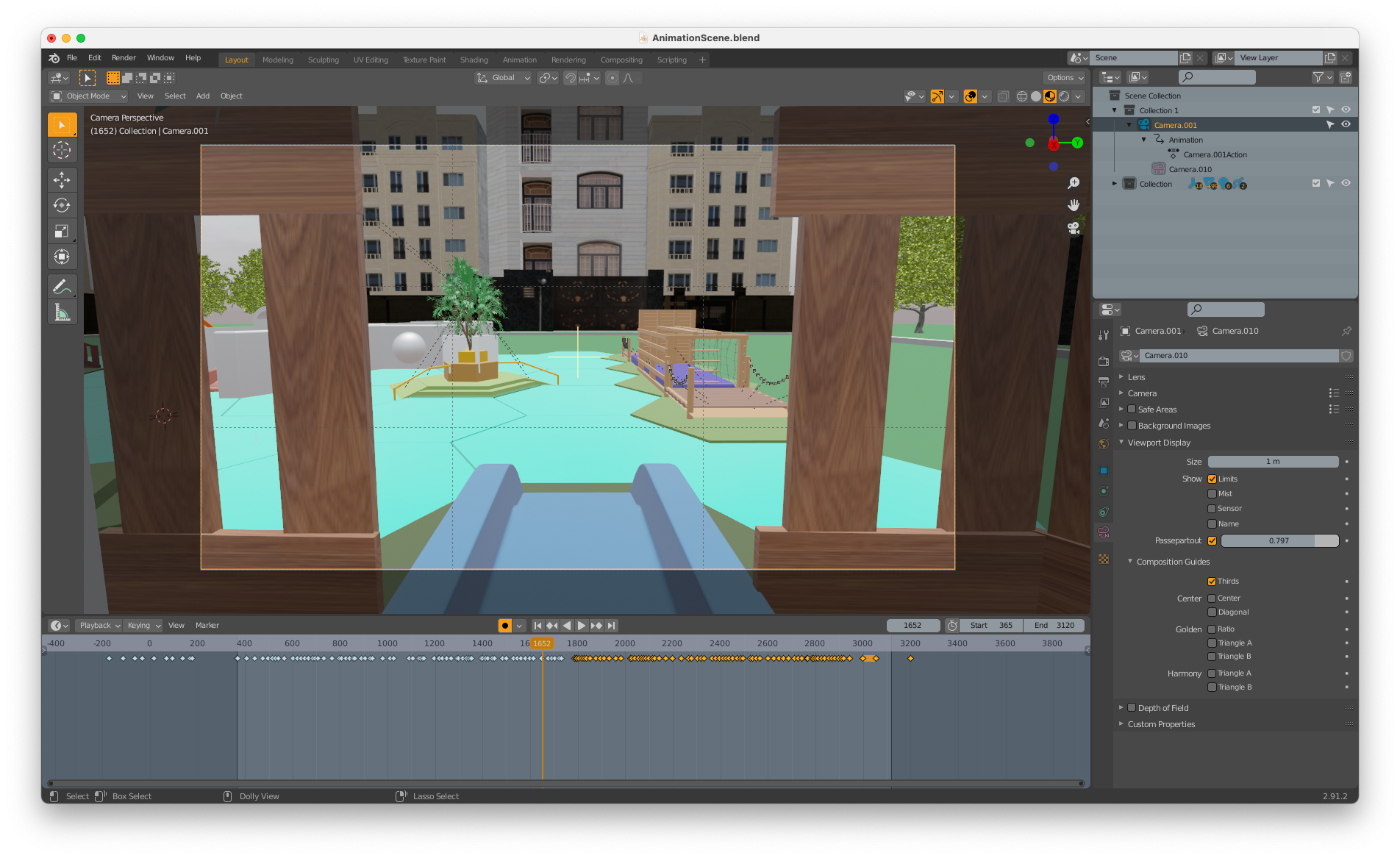

Website
Because we have so many final deliverables like each individual 3D models, rendered images, overall video and 3D prints, We think it will be better if we build a website for our project. It will be easier to showcase our work.
Our website was built using GatsbyJS, a static site generator using React.
Our models are hosted in a backblaze B2 bucket cached by cloudflare in .glb and .usdz formats. All photos are also in the same bucket.
The design was first mocked up in figma

and is a mostly faithful implementation

We used the model-viewer package to be able to display 3D models inline in the browser! (and in AR on iOS compatible devices)

Link to our project website playcomb.space
3D Printing
Tools:3D Printer, Filament
For the 3D printer, we contact Patrick from the Makerspace at Ryder. He helps with uploading our 3D files and produce the print.
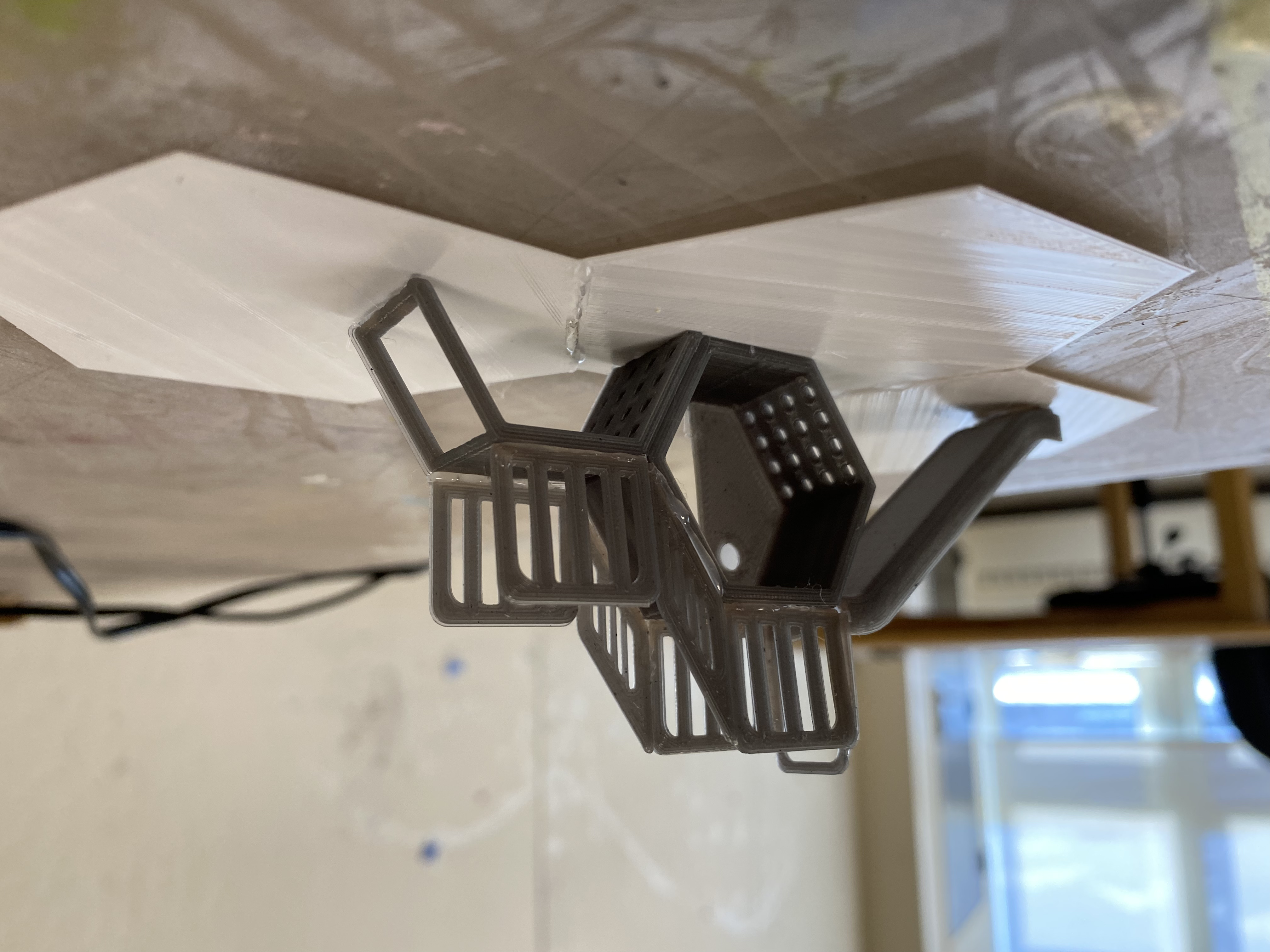
For the filament, we use a Tri Color Changing with Temperature PLA filament. This serves the purpose of the thermochromic coating of our playground's material. Kids and parents can tell if a place is recently contacted by others and can create safety interaction.
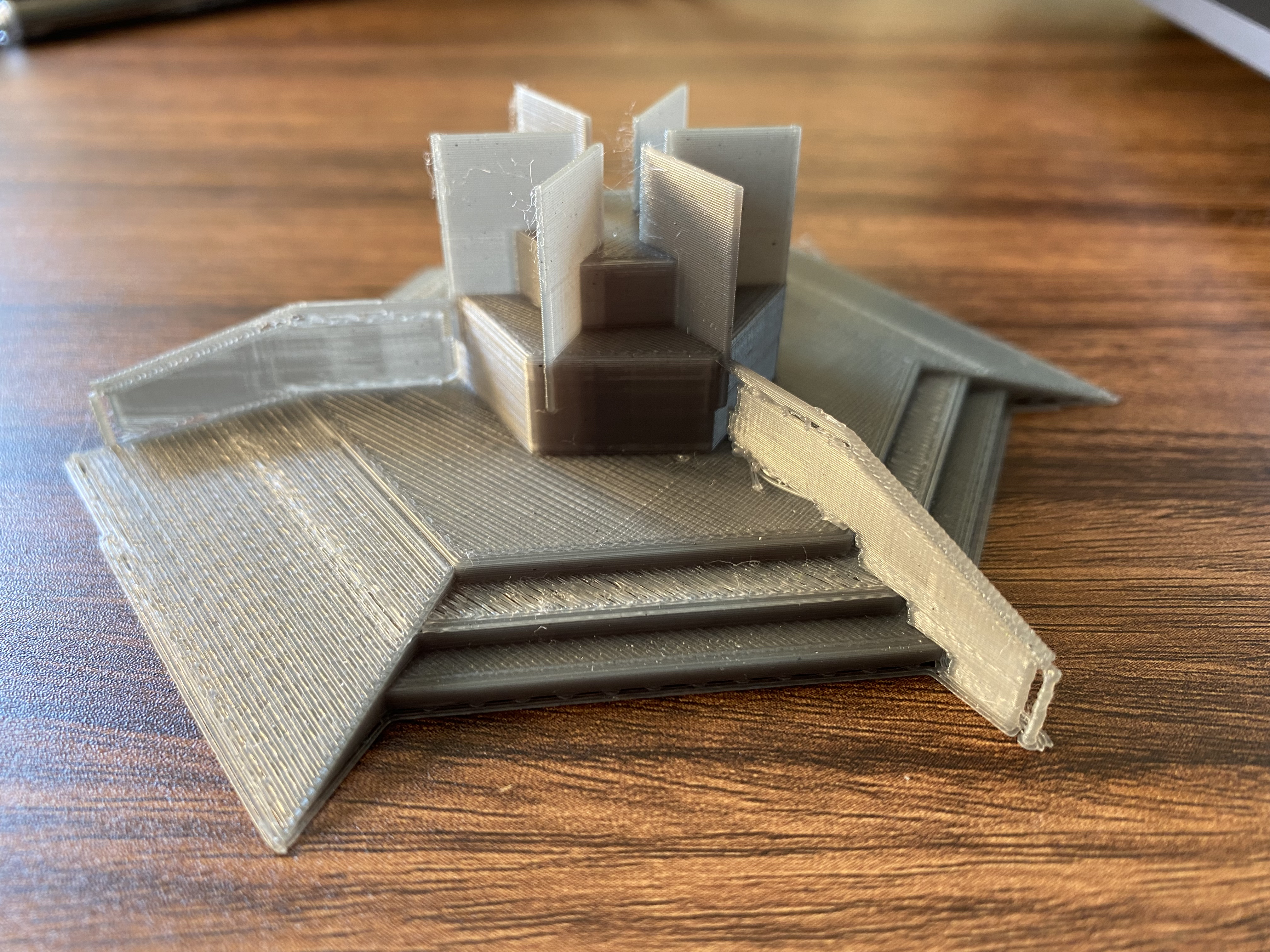
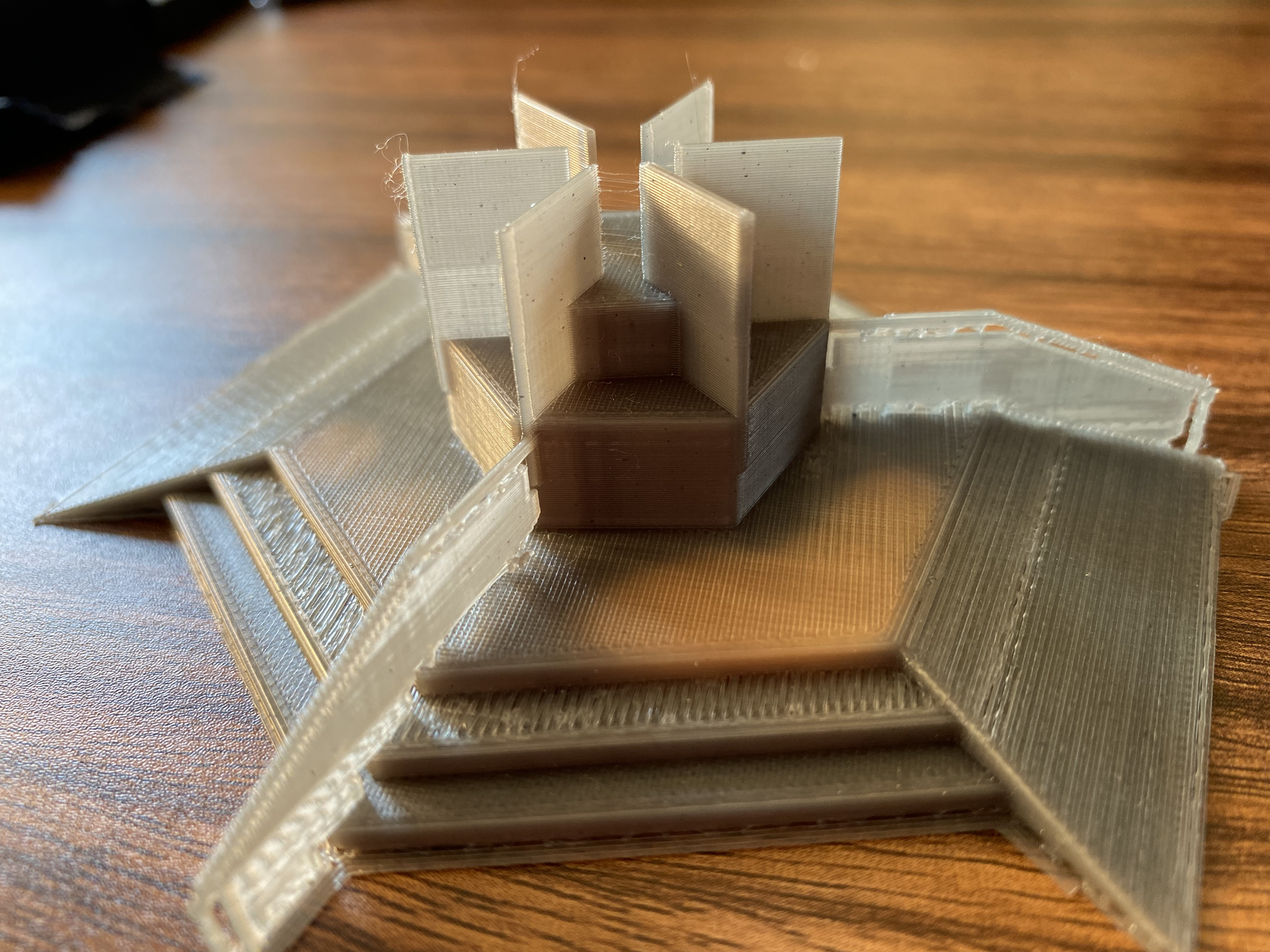
Worklog
Overview
Dustin: 3d modeling, Testing, website developer, 3D printed models
Karli: 3d modeling, Testing, website developer
Katherine: 3d modeling, Visual design and materials, content creation
Sophia: 3d modeling, Visual design and materials, content creation
Austin: 3d modeling, AR/Blender/Unity researcher and 'expert'
Weekly log:
2/16
General Updates:
- Each team member was assigned a specific island to work on, or improve, based on pre-designed metrics to standardize the models from Austin's previous testing.
- The goal for each individual was to get comfortable with the modelling software of their selection, and come to class on Wednesday with a base model to be prepared to get crit and have a working session on parts that could be improved further, so next week the islands can be considered "complete."
Specific Updates/Blockers:
- Elizabeth built the basic form for her island, using a lot of the initial shapes made by Austin, and got familar with navigation in the new software.
- Blockers: Can't build the curved bridge - unsure how to make a curved object in Blender
- Dustin built out his island - with trees from scratch to allow for his rope swing to hang correctly
- Blockers: Struggled to get waterworks area, and tree matching other islands
- Katherine built out her island in Fusion 360, incorporating feedback from an external person to make the space smaller so less kids can cram in, and not social distance.
- Karli updated 2 pre-existing islands to improve the structure and make it more representative of the 2D models.
- Blockers: Transitioning from blender to fusion caused some delays
- Austin updated existing islands, smoothing out features and making more accurate representations of the initial renderings.
Upcoming:
- We are still working out details on the best way for us to update each other and stay on track as we operate remotely, so future updates should be more systematic
- Working session this Wednesday to work through blockers and help each other out as we all learn 3D modelling at different paces
- MVP renderings seem to be ahead of schedule, so we might be able to fit more into this semester
2/23
- Dustin, Katherine, and Karli updated and standardized their islands based on pre-determined systems that we discussed last week and brought up to the "MVP" standard we hoped to achieve.
- Elizabeth, Sophia, Austin, (and Katherine too at first), had heavy technical issues with our modelling software's, between the systems either crashing PCs, uninstalling the software or other issues. We all hope to complete islands up to a level we are happy with by tomorrow, but currently we are behind schedule due to the technical issues.
3/2
- Dustin, Sophia, Katherine, and Austin did refinement on key areas of islands including: slide shape, addition of protective handrails, adding interactive panels.
- Karli took on Elizabeth’s island (due to her computer problems) and brought it up to a MVP level
- Elizabeth started piecing together how we’ll be producing AR, Video, and/or physical model for the final deliverable in addition to establishing procedures for user testing.
- Austin also started mocking our islands relative to a real playground’s size
3/10
- Sophia:
- Refined on the design of the entrance sign
- Instead of elevating the wall, I added an protective top above the slide so kids can't climb over the wall
- Extended the slide closer to the exist door
- Elizabeth Built out a doc with details about how to transfer our products into AR/VR/3D printing, and any associated costs/materials needed to pursue these 3 versions.
- Dustin added those chains I posted earlier and established with Karli our plan/questions for testing
- Katherine and Sophia:
- we work on the visual design elements for the playground. This week our goal is to create a mood board for the color/materials of the playground.
- pick our theme color: Green tone for floor separated with primary color for play objects. (see detail color code on mood board)
- Hexagon base: we pick three green tone colors for ground level base, elevated level base and the base/path between each island.
- Hexagon base materials: Rubber floor (Fusion has Rubber as materials and can change color)
- Textures on the transparent pixel glass: for decoration and safety purpose.
- we work on the visual design elements for the playground. This week our goal is to create a mood board for the color/materials of the playground.
- Austin:
- I was able to play with different layouts, specifically the medium-to-larger sized one, and I thought this layout could work well in sectioning off different parts of the park space.
- I also looked into unity, and while it's still pretty daunting, got a little bit of understanding of what it can do
- I started to build out a sample terrain space (looks like a park in the middle of nowhere lol), but it helped me to practice building terrains, hills, and adding trees, grasses, and textures. The next thing I want to figure out is how to add textures to individual pieces of an island once either before or after theyre imported into unity.
- next steps ->
- get comfortable with navigating the scene view, it can be how we make our video
- put together assets we can use to build the surrounding parts of our environment / playground
- Karli:
- Dustin and I fleshed out our testing plan Here
- Made some nicer fixes to the Tarzan island (photos below)
- Still working on the fixes to Elizabeth’s island
3/15
- Dustin: Created presentation for Wednesday
- Karli: Worked on the presentation and added all my .objs on the drive in the models folder
- Elizabeth: Got specific details about VR providers (determining price points, and still looking into student discount), as well as confirming details with makerspace in Ryder (we can use the heat sensitive filament)
- Sophia:
- Tried adding color on the .obj files via Fusion but Fusion can only add color to the whole piece. The piece doesn’t show its color in Render as it did in design.
- Also attempted to directly add color in Unity but my Unity couldn’t open up the .obj files
- Next steps: download Blender and add texture via Blender
3/23
- Austin worked on prepping the 3D models in video/AR form for user testing
- Karli and Dustin worked with Austin to figure out logistics of getting said models in the hands of testers
- Katherine and Sophia worked on finding/creating more textures. They have found all textures for 3 out of 8 islands.
3/30
- Austin continued to improve upon our 3D models in AR to hopefully make testing easier
- Karli did her first test with a user which we’ll be making adjustments from this week
- Katherine and Sophia continued work designing/finding visuals for playgrounds
- Dustin did the required training class to be able to use the 3D printers in the maker space and looked into USDZ format for AR on Apple devices
4/6
- Katherine continued work on Treehouse island and added visuals
- Sophia created a materials research document
- Karli researched different ways to market our models
- Austin looked into using Unity for recording a ‘video’ of our models
- Dustin did user testing and will today start doing tests with 3D printing
4/13
- Dustin worked on the structure for the website
- Karli finished user testing and helped finalize the design of the website
- Katherine helped finalized the design of the website
- Sophia built 3D models for environmental pieces in our video/renderings
- Austin built the scene for our 3D models to be placed in for our video.
4/20
- Katherine: added a swirly slide to the Treehouse island and worked on copy for the website.
- Karli worked on copy for the website and css/layout fixes on the site
- Sophia worked on the poster
- Austin worked on the video should be close to complete Wednesday
- Dustin finished implementing the carousels on the website. Attempted to 3D print again but had trouble with the printers and a lack of availability. Will be trying again today.
File Manifest
Please find a Google Sheet of our file manifest here.
Or go directly to our Google Drive folder containing our files from the year here.
Credits
https://www.hags.com/en-us/designing-inclusive-playgrounds
https://www.ideas42.org/blog/designing-for-effective-physical-distancing-in-essential-public-spaces/
https://playgroundideas.org/10-principles-of-playground-design/
https://www.bbc.com/worklife/article/20191028-the-cities-designing-playgrounds-for-the-elderly
https://voiceofplay.org/benefits-of-play/
https://mom.com/momlife/4904-how-does-socialization-affect-child-development
https://www.sharp.com/health-news/how-does-limited-socialization-affect-young-kids.cfm
https://www.all4kids.org/news/blog/social-connection-on-child-development/
https://playgroundone.com/play-impact-on-kids
https://www.miracle-recreation.com/blog/why-are-playgrounds-important/#section1
https://littletikescommercial.com/blog/importance-of-playgrounds-for-developing-children/
https://medium.com/@premierparkandplay/designing-early-childhood-playgrounds-77dd7658707d